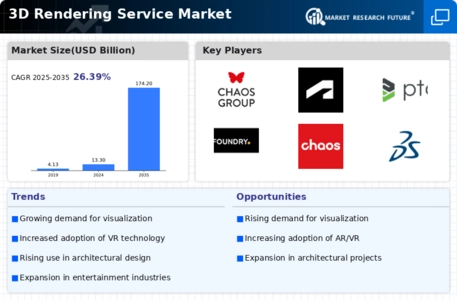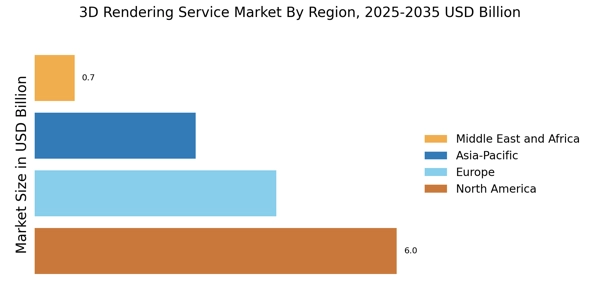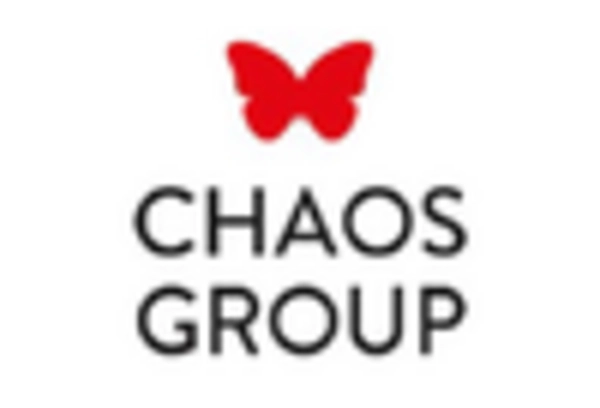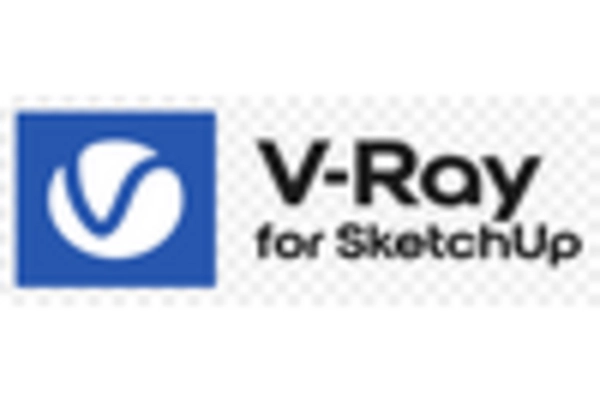Growing Demand for Customization
Customization is becoming a pivotal factor in the 3D Rendering Service Market, as clients seek tailored solutions to meet their specific needs. This trend is particularly evident in sectors such as interior design, product development, and marketing, where personalized visual content is essential for differentiation. The ability to provide customized 3D rendering services allows companies to cater to diverse client preferences and enhance customer satisfaction. Market analysis suggests that businesses offering bespoke rendering solutions are likely to gain a competitive edge. As consumer expectations evolve, the demand for customized 3D rendering services is expected to rise, further driving growth in the 3D Rendering Service Market.
Expansion in Product Visualization
The 3D Rendering Service Market is witnessing a substantial increase in product visualization applications across various sectors, including e-commerce, manufacturing, and retail. Businesses are increasingly recognizing the value of 3D rendering in showcasing products in a visually appealing manner. This trend is particularly pronounced in e-commerce, where high-quality 3D images can significantly enhance customer engagement and conversion rates. According to recent data, companies utilizing 3D product visualization report up to a 40% increase in sales. As online shopping continues to grow, the demand for 3D rendering services to create realistic product representations is likely to expand, further solidifying the position of the 3D Rendering Service Market.
Integration of Artificial Intelligence
The integration of artificial intelligence (AI) into the 3D Rendering Service Market is transforming how rendering services are delivered. AI technologies are being employed to automate and enhance rendering processes, resulting in faster turnaround times and improved quality. This technological advancement allows for real-time rendering capabilities, which are increasingly sought after in various applications, including gaming and virtual reality. The AI-driven rendering solutions are expected to capture a significant market share, as they offer cost-effective and efficient alternatives to traditional methods. As AI continues to evolve, its impact on the 3D Rendering Service Market is likely to be profound, potentially reshaping industry standards and practices.
Rising Demand in Entertainment and Media
The 3D Rendering Service Market experiences a notable surge in demand from the entertainment and media sectors. As the industry evolves, there is an increasing need for high-quality visual content, particularly in film, video games, and advertising. The 3D Rendering Service is projected to reach approximately 2.6 trillion USD by 2025, with a significant portion attributed to 3D rendering services. This growth is driven by the desire for immersive experiences that captivate audiences. Consequently, companies are investing heavily in 3D rendering technologies to enhance storytelling and visual appeal. The integration of 3D rendering in animation and special effects has become essential, indicating a robust trajectory for the 3D Rendering Service Market.
Increased Focus on Architectural Visualization
The architectural sector is a key driver for the 3D Rendering Service Market, as architects and designers increasingly rely on 3D rendering for project presentations and client approvals. The ability to create realistic visualizations of buildings and spaces allows for better communication of design concepts. Recent studies indicate that 75% of architects use 3D rendering to enhance their presentations. This trend is expected to continue, with the architectural visualization market projected to grow significantly, driven by the demand for detailed and accurate representations. As urbanization accelerates, the need for effective architectural communication through 3D rendering services is likely to become even more pronounced, reinforcing the importance of the 3D Rendering Service Market.


















Leave a Comment